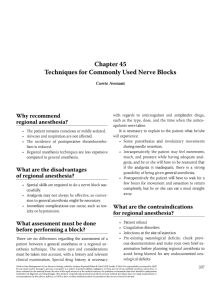Page 349 Guide to Pain Management in Low-Resource Settings
P. 349
Chapter 45
Techniques for Commonly Used Nerve Blocks
Corrie Avenant
Why recommend with regards to anticoagulant and antiplatelet drugs,
regional anesthesia? such as the type, dose, and the time when the antico-
agulants were taken.
• Th e patient remains conscious or mildly sedated. It is necessary to explain to the patient what he/she
• Airways and respiration are not aff ected. will experience:
• Th e incidence of postoperative thromboembo- • Some paresthesias and involuntary movements
lism is reduced. during needle insertion.
• Regional anesthesia techniques are less expensive • Intraoperatively, the patient may feel movement,
compared to general anesthesia. touch, and pressure while having adequate anal-
gesia, and he or she will have to be reassured that
What are the disadvantages if the analgesia is inadequate, there is a strong
possibility of being given general anesthesia.
of regional anesthesia? • Postoperatively the patient will have to wait for a
• Special skills are required to do a nerve block suc- few hours for movement and sensation to return
completely, but he or she can eat a meal straight
cessfully.
• Analgesia may not always be eff ective, so conver- away.
sion to general anesthesia might be necessary.
• Immediate complications can occur, such as tox- What are the contraindications
icity or hypotension.
for regional anesthesia?
What assessment must be done • Patient refusal
before performing a block? • Coagulation disorders
• Infections at the site of injection
Th ere are no diff erences regarding the assessment of a • Pre-existing neurological defi cits: check previ-
patient between a general anesthesia or a regional an- ous documentation and make your own brief ex-
esthesia technique. Th e same care and considerations amination before planning regional anesthesia to
must be taken into account, with a history and relevant avoid being blamed for any undocumented neu-
clinical examination. Special drug history is necessary rological defi cits
Guide to Pain Management in Low-Resource Settings, edited by Andreas Kopf and Nilesh B. Patel. IASP, Seattle, © 2010. No responsibility is assumed by IASP 337
for any injury and/or damage to persons or property as a matter of product liability, negligence, or from any use of any methods, products, instruction, or
ideas contained in the material herein. Because of the rapid advances in the medical sciences, the publisher recommends that there should be independent
verifi cation of diagnoses and drug dosages. Th e mention of specifi c pharmaceutical products and any medical procedure does not imply endorsement or
recommendation by the editors, authors, or IASP in favor of other medical products or procedures that are not covered in the text.


